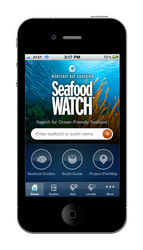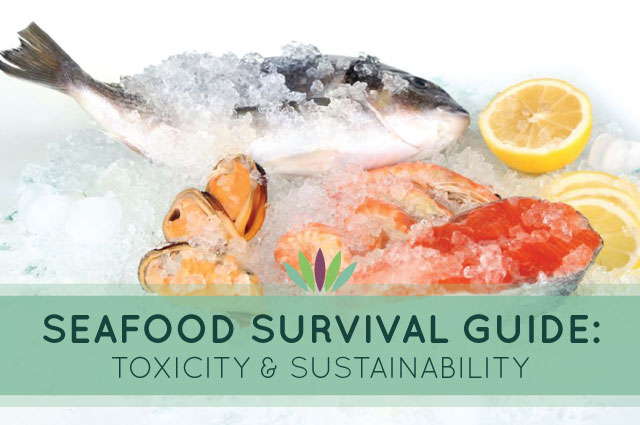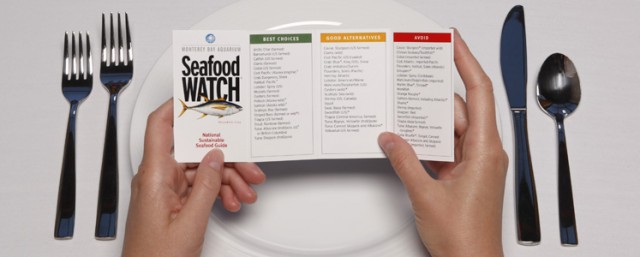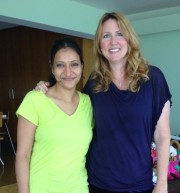Bottom line: You need to eat seafood for omega-3 and its other health benefits, but with minimal impact on your health. The question is what kind should you be eating? It’s not enough to simply “eat wild” as most Paleo sites advise.
Yes, most seafood is contaminated, but I don’t want you to avoid seafood. This is a foolish health strategy. Eating fish and seafood protects you not only from diseases like heart disease, stroke, diabetes, etc, but from all causes of death, including cancer. Fish supplies high protein, low total fat, while high in omega-3. Fish is highly contaminated today, but we need the omega-3 in our diets more than we need to avoid fish.
It was important for me to give you a definitive seafood guide to help you achieve optimum health while also helping the planet sustain its fish populations. This guide is also in my soon-to-be-released book, The Modern Paleo Survival Guide.
How to Avoid Contaminated Seafood
Concerns about the mercury in fish are overblown. We now know that selenium in fish detoxes the mercury in the fish. However, seafood, especially shellfish, are still contaminated with heavy metals like lead, cadmium and other toxic metals and industrial wastes like polychlorinated biphenyls (PCBs) and pesticides. These toxins become concentrated in older fish, large predatory fish, and in fatty species of fish. Use these tips to eat healthier fish and avoid the most contaminated seafood.
- Think Small. Eat smaller species such as sardines, anchovies, salmon, Atlantic mackerel, herring and sole. Fish that are considered a little safer include trout (farmed), catfish (farmed), fish sticks, flounder, croaker and haddock.
- Avoid freshwater fish from lakes and rivers – particularly the Great Lakes and other polluted, industrialized areas. Farmed trout and catfish are ok.
- Choose fish that come from cleaner, remote bodies of water, such as the Pacific Ocean, Alaska and remote islands.
- Avoid big predatory fish like swordfish, mackerel and shark, which accumulate more mercury. As larger ones eat smaller species, contaminants are concentrated and accumulated. Large predatory fish end up with the most toxins. Small fish do not live long enough to accumulate much if any, mercury and other worrisome toxins.
- Seafood and shellfish are much more contaminated than most fish because they live in coastal waters where there is more pollution from runoff. Clams are the least contaminated. Only eat oysters, shrimp, lobsters and other shellfish occasionally, if at all.
- Species that grow quickly (mahi mahi, tilapia, barramundi) are a better choice than slow-growing species (orange roughy, grouper, Chilean seabass) that can take 15-30 years to reach maturity, all the while gobbling up toxins.
- Avoid all seafood from China whose oceans and waterways are very polluted. Most seafood from membership warehouse clubs like Costco and Sam’s Club is from China unless otherwise labeled. You get what you pay for.
What the Labels Mean
Just as important as the type of seafood you choose is how it was caught or harvested. The type you choose can make a huge difference in your health. These are in order from best to worst.
- Wild-caught. When fish eat their natural diet, they will have more omega-3 and other nutrients. Eat wild when you can. Sadly, worldwide, wild stocks represent a finite resource with most fish stocks on the decline. The small wild-caught fish like sardines, however, are not overfished.
- Line-caught. Line-caught is the best option for top quality sustainable wild fish. The fish have been caught using the traditional fishing method of hook and line, which has minimal environmental impact. Line fishing also has no unwanted by-catch. Line-caught fish tend to be of better quality than trawled or netted fish. The long-line fishing method, however, is not good or sustainable.
- Organic. Fish or shellfish farms that have organic certification have the highest environmental standards in the aquaculture industry. The main organic certifier is Soil Association. With wild fish stocks declining, much of the fish we eat is now farmed. In the same way that we apply organic principles to farming on land, it is important that the organic principles of health, ecology, fairness and care are applied to fish and shellfish farming.
- Eco-sustainably farmed. Not all farmed fish are bad. Today, almost half of fish consumed worldwide is from aquaculture. In the next decade, the majority of fish we eat will be farm-raised, not wild, as the ocean becomes increasingly overfished. The key is to get farmed fish that are fed their natural diet and raised in a way that is not damaging to wild fish and the surrounding environment. Download a sustainable pocket guide for a list of eco-friendly fish in your area. Vital Choice is a trusted source for fast home delivery of the world’s finest wild seafood and organic fare, harvested from healthy, well-managed wild fisheries and farms.
- Farmed fish. Most farmed fish are raised just like factory-farmed meats. They live in festering pools and are routinely fed antibiotics, GMO corn and soy, growth hormones, and dyes (to make them look healthy). These fish have half the omega-3 content of wild-caught fish plus a higher omega-6 content – the exact thing you’re trying to avoid on a healthy diet. Because of higher standards and oversight, U.S. farm-raised fish and shellfish options are currently a better choice than those from Asia. Fish frequently farmed are salmon, trout, catfish, tilapia, eels, shrimp, and crayfish.
Go Sustainable
Wild-caught fish is expensive because it is getting harder and harder to catch wild fish. Nearly 75% of the world’s fisheries are currently overfished and the situation is only becoming worse as the demand for seafood increases. Seafood is considered sustainable when species populations are either naturally abundant or are maintained through regulation. Additionally, seafood is sustainable when fishing and harvesting methods don’t harm natural habitats, other species, or the environment. How to find sustainable seafood:
 Read Labels. Improved labeling in recent years has helped shoppers make better choices in the supermarket. These labels may show country of origin, whether the seafood was farm-raised or wild-caught, and even the fishing/harvesting method.
Read Labels. Improved labeling in recent years has helped shoppers make better choices in the supermarket. These labels may show country of origin, whether the seafood was farm-raised or wild-caught, and even the fishing/harvesting method.- Look for Logos. Choose seafood products that are certified as sustainable by organizations with tough standards like the Marine Stewardship Council and Friends of the Sea.
- Pocket Guide. The regional and national Pocket Guides available for download from the Monterey Bay Aquarium’s Seafood Watch Program are a convenient way to keep sustainability information when dining out locally or while traveling.
- Get the App. You can now download a free Seafood Watch application for your iPhone or any mobile device. There are good seafood farms and good wild fisheries; there are bad farms and bad wild fisheries. It’s more helpful to look up each species on this app.
Current list of Safe Fish
These fish are currently on the Monterrey Bay Aquarium’s Seafood Watch “Super Green List.” They have identified seafood that’s “Super Green,” meaning that it’s low in mercury and other toxins and is caught or farmed responsibly. The recommendations on this list draws from experts in human health, notably scientists from the Harvard School of Public Health (HSPH) and Environmental Defense Fund (EDF). Enjoy some guiltless gorging with these species. Please note the Monterrey Bay Aquarium is only rating fish found in the United States and surrounding areas. Other fish, like sardines from Portugal are of course a great choice, as are other small fish from around the world.
The “Super Green List” includes seafood that meets the following three criteria:
- Has low levels of mercury (below 216 parts per billion [ppb])
- Provides at least 250 milligrams per day of omega-3
- Is classified as a Seafood Watch “Best Choice” for sustainability
The “Super Green List”: July 2013
- Atlantic Mackerel (purse seine from Canada and the U.S.)
- Freshwater Coho Salmon (farmed in tank systems, from the U.S.)
- Pacific Sardines (wild-caught)
- Salmon (wild-caught, from Alaska)
- Salmon, Canned (wild-caught, from Alaska)
Other Healthy “Best Choices” (more mercury, less omega-3 than “Super Green List”)
- Albacore Tuna (troll- or pole-caught, from the U.S. or British Columbia)
- Sablefish/Black Cod (from Alaska and Canadian Pacific)
Safe Sushi Guide
Here’s my problem. I love sushi! Anyone else out there a sushi addict? Are you knowingly devouring sushi at your own peril? I know I am! Being the clever little Neolithic Homosapien that I am, I’ve developed a little sushi strategy with the help of the Monterrey Bay Aquarium’s Sushi Guide. This way, I can eat the safest, most sustainable seafood possible, preserving my health and fish populations. I can enjoy my sushi with at least partial peace of mind and not feel like I’m destroying the planet while devouring some uni (sea urchin). Plus, whatever toxins I do ingest, I just detox in my near infrared sauna. Ah, problem solved!
The Monterrey Bay Seafood Watch program even has a Sushi Guide!!
A Smart Seafood Strategy
The smartest seafood strategy is to stick to small fish like salmon, sardines, Atlantic mackerel and fresh anchovies (not the nasty ones on pizza), with a very occasional indulgence in seafood “off the safe list.” Then, detox the seafood toxins you currently have in your body.
Hair mineral analysis always reveals who is eating too much mercury-laden fish and seafood by their higher mercury levels. There is a certain kind of joy in busting my clients eating too much of the wrong seafood. A hair mineral analysis is the basis for a Myers Detox protocol that serves to help you detox any toxins you’ve picked up from seafood. It’s a great seafood survival strategy that takes any worry out of eating lobster. Think about it. Being on top of the food chain, you are now the predator accumulating toxins.











